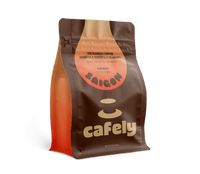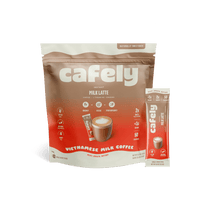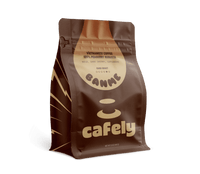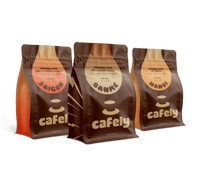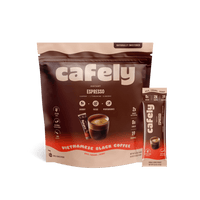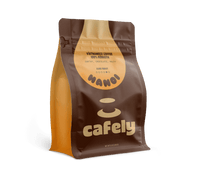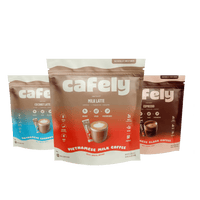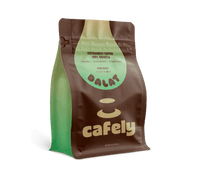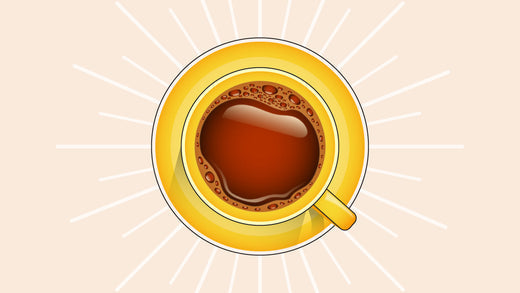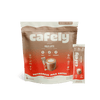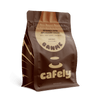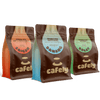Sometimes, we’ve just got to stay up late, whether it’s to look after a cranky little one, finish that critical presentation, or binge-watch an addictive TV series. Thankfully, coffee can help you the next morning by providing temporary energy and focus.
Finding the best coffee to keep you awake doesn’t have to be a complex process of trial and error.
In this guide, we look at the best types of coffee to keep you awake and how to prepare a turbo brew that’s guaranteed to keep those tired eyes open.
What’s the Best Coffee to Stay Awake?
All types of coffee (except decaffeinated) contain caffeine — a fast-acting stimulant that provides a boost of energy. However, some types of coffee and certain brewing methods produce more caffeine than others. The best coffee to stay awake should contain high levels of caffeine.
Here’s what to look for when selecting the best coffee to stay awake:
- Robusta coffee — Robusta beans produce around twice as much caffeine as arabica beans. Brews made with some of the best robusta coffee brands are much stronger, providing a more noticeable and prolonged energy boost. 100% robusta coffee is the best coffee to stay awake.
- Robusta & Arabica Blends — Although 100% robusta is the best option in terms of caffeine content, its bitter flavor profile isn’t for everyone. Arabica and robusta blends provide a comparable caffeine hit but a smoother flavor profile.
- Instant Coffee — Although instant coffee doesn’t provide the same depth of flavor as regular whole or pre-ground coffee, it’s a good option for staying awake. Instant espresso blends offer convenience and a strong hit of caffeine.
- Brewing Technique — Besides bean choice, the brewing method used to make the coffee will affect its ability to keep you awake. Espresso machines, moka pots, Aeropress brewer, and drip coffee makers (when the coffee-to-water ratio is raised) make the strongest coffee.
How Does Coffee Keep You Awake?
Coffee's main way of keeping you awake is through caffeine.
Your body naturally releases the hormone adenosine, which binds to receptors in your brain, triggering the tired feeling experienced before you sleep. Put simply, caffeine molecules and adenosine molecules “fit together” — they bind to your brain's adenosine receptors [1].
When you drink coffee, caffeine dissolves into your bloodstream, where it travels to the cerebral cortex and hippocampus. Adenosine receptors in these regions act like a “parking lot” — both the caffeine and adenosine want the same spot, but caffeine can get there quicker and even push adenosine out.
Once your adenosine receptors are full of caffeine, you no longer feel the tiredness that the hormone triggered. So, while you’re technically at the same level of tiredness in your muscles and cells, caffeine creates the illusion of you feeling less tired overall.
How to Choose the Best Coffees to Help You Stay Awake

When selecting a coffee to help you stay up, going for maximum caffeine is a great plan. But there are so many things to consider when buying coffee beans.
Take a look at the guide below to help you choose the strongest, most energizing coffee:
1. Coffee Bean Type
There are lots of different types of coffee beans produced by different species of Coffea plants. However, the most common are Coffea robusta (robusta coffee) and Coffea arabica (arabica coffee). These two beans are similar but have different caffeine concentrations.
A) Robusta
Robusta is the most caffeine-potent coffee bean out there, with around twice as much caffeine as arabica (the most popular type of bean). The coffee plant evolved to avoid insects by generating caffeine. Because the robusta plant produces high levels of caffeine, it’s much more “robust” — it grows bigger and quicker than arabica plants and is more hardy to pests.
Robusta beans tend to benefit from being roasted to a dark level — this develops a lot of natural sweetness, as well as the earthy, dark flavor they’re famed for. Dark-roasted coffee lends itself well to high-extraction brewing methods, which can pull a lot of caffeine out of coffee as you brew. So, try using a dark roast robusta with a phin filter or moka pot to produce the strongest cup.
B) Arabica
Arabica coffee beans have less caffeine than robusta but more fat and sugar. This means that their flavor is more complex and delicate. The beans are often roasted more lightly than robusta to preserve these delicate flavors. To get these citrus and nut notes out of light roast arabica coffee beans, pour-over or French press brewing is often recommended.
These brewing methods involve a longer contact period between the coffee and water, so the beans’ flavors slowly dissolve into the brew. This might seem counter-intuitive, but many people find that a peaceful break can help them take a deep breath and stay awake. For instance, stepping out of a late night in your home office to brew in your kitchen can give your brain a change of scenery, helping to pep you up almost as much as the caffeine in the coffee will.
C) Blends
Blends of arabica and robusta create a balanced, complex flavor that combines the best parts of all the beans.
This balance of flavors, aromas, and caffeine content can create a delicious brew that packs a punch. While the caffeine content of one cup can be enough to keep you awake for a little while, a drip feed of delicious coffee can be perfect to keep you awake through a long night.
2. Roast Level
Roasting coffee to different levels may impact its caffeine content slightly, though it’s typically not enough to impact your brew too much. Let’s talk about how different roasts might help you stay up a little longer.
A) Light Roast
When the beans are green, the caffeine within them is dissolved within tiny pockets of water throughout the bean’s structure. When you roast coffee, this water evaporates, and it takes some of the caffeine with it while making a less dense bean. So, to get the most caffeine in the fewest beans, opting for one of the best light roast coffees might be the best choice for you.
B) Medium Roast
A medium roast coffee is “the sweet spot” between the complex sweetness and bitterness of a dark roast and the increased aroma and caffeine content of a light roast. If you’re unsure where to start in your journey of specialty coffees, try starting with the best medium roast coffee — it’s very likely to create a tasty cup of coffee that’s a good all-rounder.
C) Dark Roast
While not every dark roast is made with robusta beans, a great deal of robusta beans are processed to a dark roast. Robusta beans have a naturally higher caffeine content than arabica beans, so if you’re on the lookout for a high-caffeine coffee, then explore some of the best dark roast coffee options and make sure to check their robusta content as well.
D) Butter Roasted
Butter roasting coffee is a traditional Vietnamese practice, which involves tossing the beans you're roasting with butter before roasting begins. This adds flavor to the coffee because both the beans and the butter interact to create new, complex flavors that bring added notes of richness to the brew.
Although butter-roasted coffee contains the same amount as dry-roasted, this added complexity could be a good way to stimulate your brain to stay awake. If you’ve been staring at the same problem for a number of hours, giving your brain something new to focus on can be a great way to give it a little boost.
3. Growing Practices
At first glance, you may not think that growing practices would have a huge impact on coffee, but consider how different a supermarket tomato and a home-grown one taste. With a little extra love and care, any crop can be spectacular.
Organically Farmed Coffee
Organic growing practices are the best way to ensure no synthetic contaminants enter your mug. They can also be a good way to avoid any kind of forced ripening, which sometimes happens with fruit crops such as coffee.
The “hurrying” of the crops can lead to food being harvested without having a chance to develop the kind of complex flavors that patience allows for. Organic farming allows the plants to grow and age at their own rate, ensuring each crop is packed with flavor and nutrients.
Top-quality, organic coffee is a great way to ensure you’re staying awake, both because you can be sure you’re not ingesting pesticides and because the flavor can be more profound.
Certified Mold-Free Coffee
Mold is a common issue in coffee beans. During the drying, roasting, packaging, and shipping processes, mycotoxin-producing mold can form on the beans. Mycotoxinscan have a detrimental impact on human health.
Ensuring that you track down a coffee that’s been thoroughly tested and checked to ensure it’s mold-free is a great way to ensure your coffee is clean and pure.
4. Stronger Caffeine Content
When you’re looking for coffee with a lot of caffeine, it’s important to think about caffeine density. While you could have four cups of coffee, it would be easier to have a coffee that’s twice as strong and only drink two.
The strongest coffee out there is peaberry robusta. Robusta is already known to have about double the caffeine of arabica, and the peaberry variety is thought to have a more concentrated nutrient profile (caffeine included).
When you need a super strong coffee, you might be too tired to stand around making it. There are also impressive robusta-based instant coffee products that pack in the caffeine.
How Can You Make Your Coffee Wake You Up Better?

When you’re having that first cup of coffee in the morning, you may feel that just one cup doesn’t quite break through your intense sleepiness. Luckily, you can do a couple of things to improve the effectiveness of your cup and enjoy the best morning coffee that's strong enough to get your day started.
1. Grind Your Beans Finer
When we brew coffee, we’re essentially dissolving chemicals from the coffee into water — caffeine included. When the grounds are discarded we’re left with a caffeinated infusion.
One of the best ways to get more caffeine from your beans is to enhance the extraction process [2]. Often, the easiest way to do this is to grind your coffee beans more finely, thereby increasing the surface area that comes into contact with the water during brewing.
More contact between the grounds and the water will lead to greater extraction, which could result in a higher level of caffeine in your final cup. However, it could also lead to an over-extracted flavor, so the goal is to find the balance between these two.
2. Add Sugar
Adding a little sugar to your coffee can help you stay awake by providing fast-burning fuel for your body. Granulated sugar is converted to glucose in the body — a simple molecule that our bodies easily break down, distribute, and use for energy. In fact, glucose is our bodies' primary energy source.
While consuming a lot of sugar in your day-to-day life is unhealthy, adding extra sugar to your coffee once in a while can boost energy when you need to stay awake. It’s important to remember that your body uses glucose quickly, resulting in a sugar high followed by a crash. So this is only really a short-term solution (much like caffeine).
3. Add Milk
Adding a little milk to your coffee adds protein and fat. Both of these nutrients can be great energy sources, and your gut will readily convert them into energy for your body to use, especially in the morning when your body is in a fasted state.
A good option is to try adding a healthy dose of condensed milk to your brew, adding both sugar and milk through this Vietnamese tradition. Condensed milk works well with dark-roasted robusta coffee. The balance between a dark roast's bitter earthiness and the milk's rounded caramel notes creates a delightfully sweet, well-rounded brew.
4. Drink Water
The caffeine from your coffee can only make its way into your brain if you’re appropriately hydrated. If you’re not hydrated, then your body will divert water to important organs and less so to the stomach, where caffeine is absorbed.
Having a glass of water alongside a cup of coffee can help hydrate you and circulate the caffeine through your system more readily. This may be especially wise when you first wake up — while you’re asleep, you’ve not drunk any water.
FAQs: Best Coffee for Staying Awake
Want to learn more about how coffee helps you stay awake?
Read through the answers to some of our most frequently asked questions:
1. What’s The Best Coffee to Stay Awake?
Our number one choice is Cafely’s BanMe coffee — this peaberry robusta blend packs a punch with twice the amount of caffeine than arabica. Another brilliant option is instant espresso sachets. These can be made in no time at all and contain twice as much caffeine as a regular espresso.
2. Why Does Coffee Help You Stay Awake?
The caffeine that coffee gives you blocks adenosine receptors in your brain. Ordinarily, adenosine makes you feel sleepy. When caffeine blocks the adenosine from working, you don’t feel sleepy. Technically, though, you’ll still be physically tired, and the caffeine just creates the illusion of wakefulness — but it’s better than nothing.
3. Where Does Caffeine Come From?
Caffeine is most commonly obtained from plants such as coffee or tea. Researchers are also experimenting with synthetic caffeine.
4. What Other Things Can Help You Stay Awake?

Drinking or eating something high in sugar can replenish your body's stores of glucose, which it needs for energy. This can help you and your body feel refreshed. You can also do some exercise, which helps your body turn stored energy into energy you can use, so a little bit of exercise can trigger the process and help you feel more alert.
5. What’s the Best Way to Drink Coffee To Stay Awake?
Perhaps the simplest way to drink coffee to stay awake is to enjoy a single shot of espresso. A single espresso typically has around 100 mg of caffeine in it, which is roughly the same as a whole mug of drip coffee. If that’s not strong enough, you might want to give red eye coffee a try. It’s a bold blend of drip coffee and espresso that’s perfect for long, sleepy days.
6. What Coffee to Order When Tired?
There are all sorts of super-caffeinated beverages that you could order when you’re tired, for instance, Vietnamese Coffee is a concentrated robusta coffee with condensed milk — so you get sugar, extra calories, and caffeine in your system.
7. What Coffee is Best for the Most Caffeine?
To pack the caffeine into a small parcel, aim for espresso. A blend of arabica and robusta beans is used to make a traditional Italian espresso, which makes for a complex, rounded, and “finished” flavor. To get even more caffeine, though, you could try an instant espresso — these are quick to make, and pack a punch.
References:
- Giesbrecht, T., Rycroft, J. A., Rowson, M. J., & De Bruin, E. A. (2010). The combination of L-theanine and caffeine improves cognitive performance and increases subjective alertness. Nutritional neuroscience, 13(6), 283–290.
- Xiuju Wang, Loong-Tak Lim, Effects of grind size, temperature, and brewing ratio on immersion cold brewed and French press hot brewed coffees, Applied Food Research, Volume 3, Issue 2, 2023, 100334, ISSN 2772-5022,
